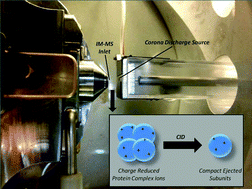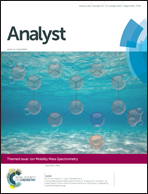Ion mobility-mass spectrometry of charge-reduced protein complexes reveals general trends in the collisional ejection of compact subunits†
Abstract
Multiprotein complexes have been shown to play critical roles across a wide range of cellular functions, but most probes of protein quaternary structure are limited in their ability to analyze complex mixtures and polydisperse structures using small amounts of total protein. Ion mobility-mass spectrometry offers a solution to many of these challenges, but relies upon gas-phase measurements of intact multiprotein complexes, subcomplexes, and subunits that correlate well with solution structures. The greatest bottleneck in such workflows is the generation of representative subcomplexes and subunits. Collisional activation of complexes can act to produce product ions reflective of protein complex composition, but such product ions are typically challenging to interpret in terms of their relationship to solution structure due to their typically string-like conformations following activation and subsequent dissociation. Here, we used ion–ion chemistry to perform a broad survey of the gas-phase dissociation of charge-reduced protein complex ions, revealing general trends associated with the collisional ejection of compact, rather than unfolded, protein subunits. Furthermore, we also discover peptide and co-factor dissociation channels that dominate the product ion populations generated for such charge reduced complexes. We assess both sets of observations and discuss general principles that can be extended to the analysis of protein complex ions having unknown structures.

- This article is part of the themed collection: Ion Mobility Mass Spectrometry

 Please wait while we load your content...
Please wait while we load your content...